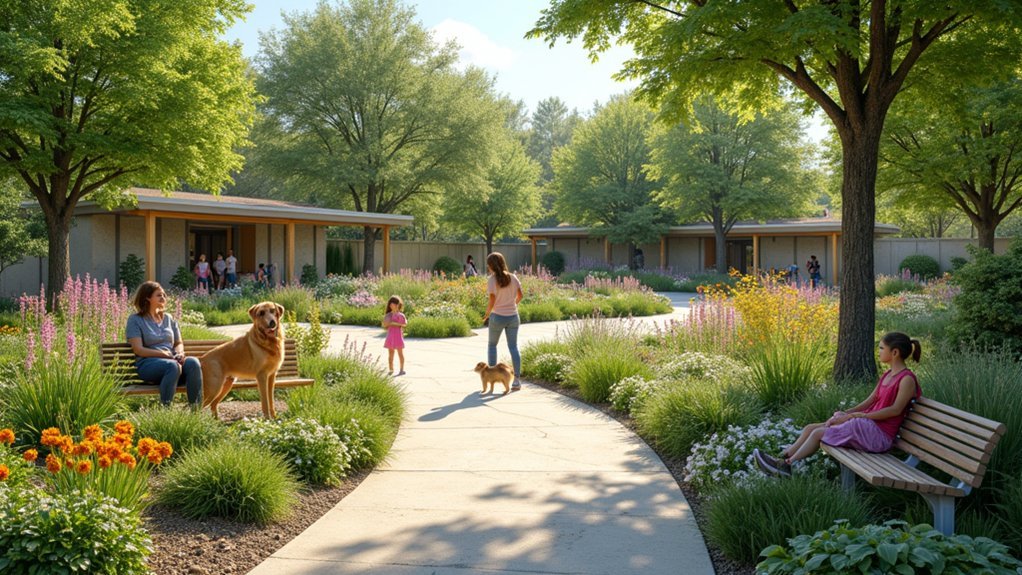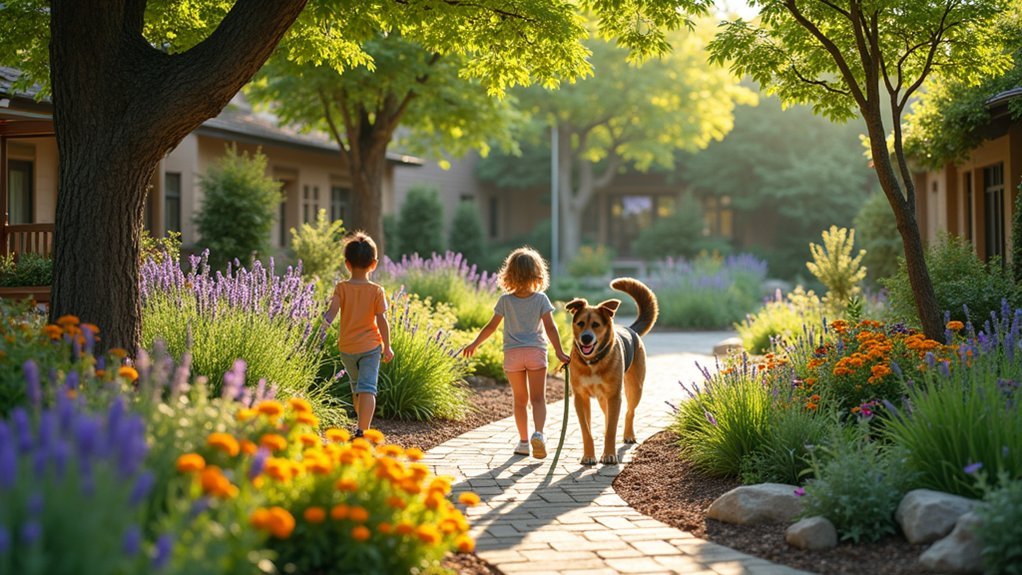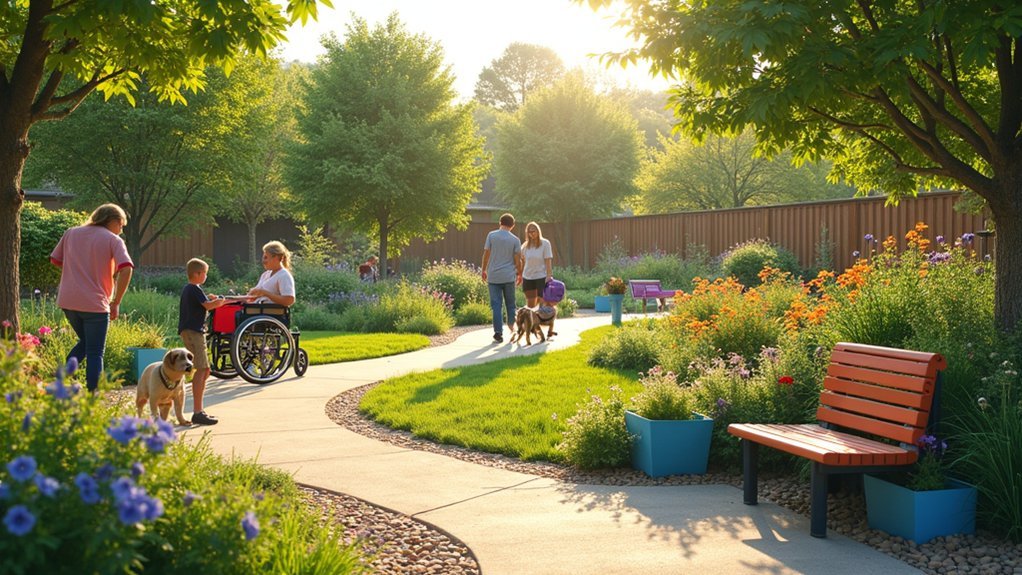Inclusive animal therapy gardens feature wide, obstacle-free pathways for mobility aids, raised beds at wheelchair height, and strategically placed seating areas. You’ll find multi-sensory elements like aromatic plants, diverse textures, and inviting animal interaction zones. These spaces often incorporate non-toxic, high-contrast plantings and specialized adaptive tools for everyone’s participation. When designed well, these gardens support physical healing, reduce anxiety, and foster community connections through shared animal experiences. The following options combine accessibility with therapeutic animal interactions for all abilities.
Designing Accessible Animal Interaction Spaces

While creating animal interaction spaces that everyone can enjoy requires thoughtful planning, the rewards are immense for both visitors and wildlife.
Thoughtful design transforms animal spaces into inclusive sanctuaries where connections between humans and wildlife flourish.
You’ll need to focus on pathway accessibility by ensuring paths are wide, smooth, and free of obstacles for mobility aid users.
Install seating areas at regular intervals so visitors can rest while engaging with animals and plants. Keep gradients minimal to accommodate those with mobility challenges.
Position plants and interactive features at accessible heights for all visitors, including wheelchair users and children.
Incorporate multi-sensory elements through diverse plant textures, fragrant herbs, and auditory features like wind chimes or water elements. Selecting appropriate native plants will provide reliable food supplies throughout the seasons for various wildlife species.
Don’t forget practical considerations like nearby accessible toilets and clear signage.
These thoughtful design elements create inclusive spaces where everyone can benefit from therapeutic animal interactions.
Therapeutic Benefits of Multi-Sensory Plant-Animal Gardens
Multi-sensory plant-animal gardens offer remarkable therapeutic benefits that extend beyond the accessible design features we’ve explored.
These environments combine the healing properties of plants with animal interaction, creating powerful spaces for health improvement across physical, emotional, and cognitive domains. Similar to sensory gardens, they are designed to be fully inclusive, catering to users of all ages, needs, and abilities.
- Stress reduction and healing – Gardens with animals provide dual therapeutic effects, greatly lowering anxiety and supporting pain management through both nature immersion and animal companionship.
- Complete sensory activation – Your senses become fully engaged through visual diversity, natural scents, tactile opportunities, and soothing sounds of both plants and animals.
- Enhanced cognitive function – You’ll experience improved memory, attention, and problem-solving skills through varied environmental stimulation.
- Social connection opportunities – These spaces naturally foster community engagement and relationship building, combating isolation through shared experiences.
Inclusive Garden Features for Animal-Assisted Therapy

Creating truly inclusive garden spaces for animal-assisted therapy requires thoughtful design elements that accommodate diverse abilities and needs.
Focus on installing smooth, non-slip pathways wide enough for wheelchairs and mobility aids, with strategically placed rest areas for those needing frequent breaks.
Incorporate raised plant beds at wheelchair height and select non-toxic, non-thorny plants with high-contrast colors to benefit visitors with low vision.
Include aromatic plants like lavender for sensory stimulation and create quiet zones for those requiring low-stimulation environments.
The ideal raised bed height of 30-36 inches for sitting gardeners ensures comfortable access for therapy participants using wheelchairs.
Design layouts that enable clear sightlines for safety and easy supervision during therapy sessions.
Install proper infrastructure such as handwashing stations near animal interaction areas, and use clear signage with symbols and braille to support navigation for all users.
Sustainable Wildlife Habitats for Diverse Therapeutic Needs
Sustainable wildlife habitats form the backbone of effective animal-assisted therapy gardens by extending therapeutic benefits beyond domestic animals to local ecosystems.
Creating spaces that support native plants, implement water conservation, and maintain soil health enables you to develop therapeutic environments that serve both wildlife and diverse human needs.
- Native pollinator sanctuaries create mesmerizing visual displays while supporting critical ecosystem services and providing calming sensory experiences for therapy participants. Our commitment to improve the earth for all living things drives our focus on creating truly sustainable wildlife habitats that enhance therapeutic settings.
- Rain gardens manage water runoff while attracting diverse wildlife, offering educational opportunities about resilience and adaptation.
- Wildlife corridors connect fragmented habitats, symbolizing healing journeys and continuity for therapy clients.
- Community-built habitats foster social connections and ownership while enhancing the therapeutic value through meaningful contribution to conservation efforts.
Adaptive Equipment and Pathways for Animal Engagement Areas

Designing adaptive equipment and pathways guarantees that animal engagement areas remain accessible to visitors of all abilities while maintaining the therapeutic value of human-animal interactions.
You’ll find smooth materials like concrete or wood for pathways that accommodate wheelchairs and walking aids, complemented by wide entry points and level ground to prevent tripping.
Specialized tools with grip handles allow everyone to participate in animal care activities, while sound-absorbing materials reduce noise that might stress animals or visitors.
Interactive displays provide essential information about animal welfare, creating educational opportunities alongside therapeutic experiences.
For maximum accessibility, incorporate ramps, handrails, and strategically placed benches throughout the space.
Regular maintenance, slip-resistant coatings, and proper lighting guarantee these spaces remain safe environments where healing interactions can flourish.
The addition of sensory exploration elements enhances the therapeutic experience, encouraging visitors to engage with different textures, smells, and visual differences in the garden environment.
Frequently Asked Questions
What Insurance Considerations Apply for Therapy Animals in Public Gardens?
You’ll need specialized insurance for therapy animals in public gardens. Register with therapy dog organizations for coverage, conduct risk assessments regularly, and guarantee your garden has proper liability protection and ADA compliance protocols.
How Are Seasonal Changes Managed in Animal Therapy Gardens?
You’ll need to adapt your garden year-round with indoor winter programs, spring planting activities, outdoor summer events, autumn harvest themes, and consistent maintenance to guarantee animal welfare and therapeutic benefits throughout all seasons.
What Certifications Do Staff Need for Animal-Inclusive Therapeutic Spaces?
You’ll need certification as an Animal-Assisted Intervention Specialist (C-AAIS) if you’re over 18. While no national mandate exists, you should register with organizations like Pet Partners and complete handler-animal team evaluations with supervised visits.
How Are Allergies and Phobias Addressed in Inclusive Therapy Gardens?
You’ll find that inclusive therapy gardens address allergies through hypoallergenic plants and medication stations, while phobias are managed with gradual animal introduction, quiet zones, and trained support teams for your comfort and safety.
What Cultural Considerations Influence Animal Therapy Garden Design?
Cultural considerations influence animal therapy garden design through your selection of culturally appropriate animals, symbolic elements, and spaces that respect religious beliefs, taboos, and traditional practices while honoring diverse community needs and boundaries.
In Summary
You’ll find that inclusive animal therapy gardens offer transformative healing potential for everyone, regardless of ability. By incorporating accessible pathways, sensory-rich plantings, and adaptable interaction zones, you’re creating spaces where both humans and animals thrive together. Whether you’re planning a small sensory corner or extensive therapeutic landscape, your thoughtful design choices will make animal-assisted healing accessible to your entire community.





Leave a Reply